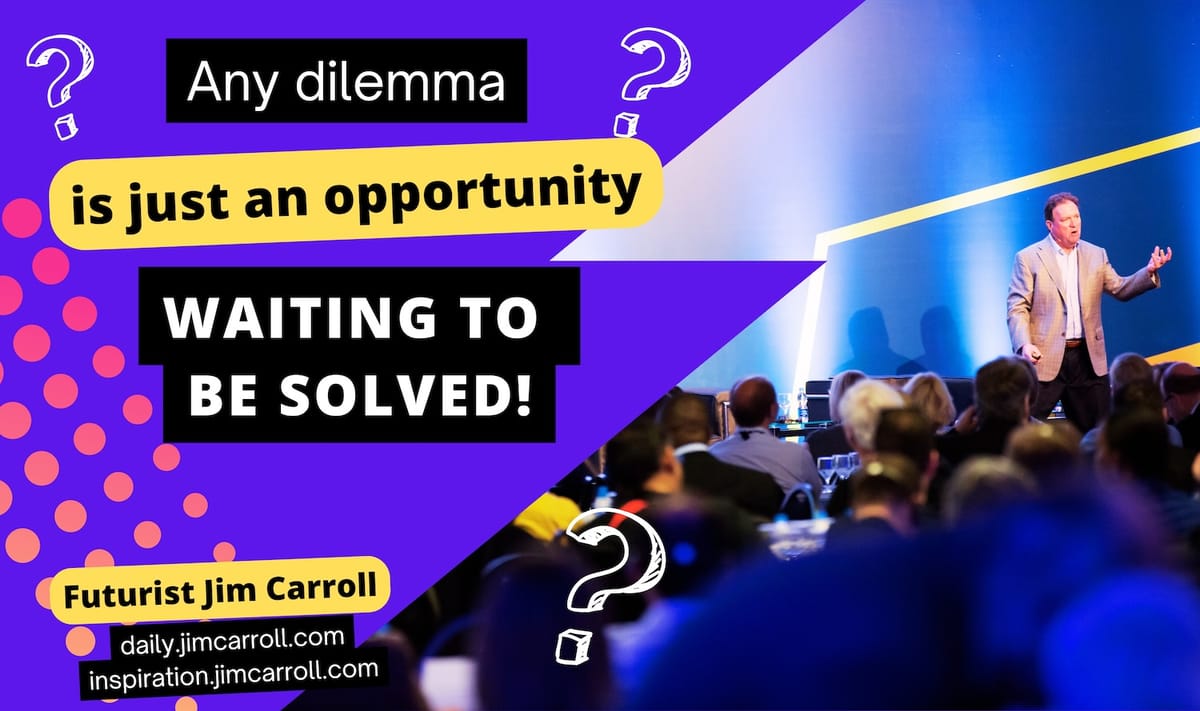"Any dilemma is just an opportunity waiting to be solved!" - Futurist Jim Carroll
Organizations and the people that lead them become stuck because they aren't sure how to solve the problems that they face. In the meantime, those who realize that those problems or dilemmas are really just opportunities in disguise and charge ahead. The results are all too predictable.
Yet, in our fast world, these dilemmas are real. Every leader is faced with the challenge of fostering a culture of innovation vs. maintaining operational efficiency. Build new products or shave costs? What to do, what to do? In every situation, you've got to strike a careful balance between encouraging experimentation, risk-taking, and creative thinking (which can be disruptive and inefficient in the short term) while continuing the relentless chase for efficiency, cost savings, productivity, and cost control. This tension, to say the least, can be challenging to manage.
Innovation itself presents a dilemma. Do you allocate limited resources (financial, human, and technological) for innovative new projects, products, and ideas, or do you focus on sustaining and enhancing the core business? Do you embrace disruptive new business models, or work harder to protect existing revenue streams? Do you jump on a new trend now - or later? Would you embrace open innovation and product models with such things as open-source development, or do you keep a closed shop? Chase radical, no-holds-barred innovation, or methodical, step-by-step innovation?
I've seen these challenges play out over and over again in the organizations I work with and the leadership teams that book me. Some industries have had the dilemma, literally, for decades. Legacy insurance organizations have long been faced with the dilemma of the potential for direct-to-consumer business models vs. closed, propriety captive agent and broker networks. Should they try to sell insurance through an online or mobile system, or continue to sell it only through an existing group of agents who work on commission? Known as disintermediation, the dilemma has existed for decades, and some organizations are still working hard to figure it out.
So too are auto companies as they deal with the challenge of whether they should try to sell cars online - as Tesla does - or continue to do so solely through automotive dealer networks. It's a massively complex dilemma with no easy answers and a lot of significant challenges such as lawsuits and legislative activities. Retailers? They are faced with the issue of either investing in their stores with upgrades or building out their e-commerce and logistics infrastructure.
And then there are the dilemmas that every one of us faces on a day-to-day basis. Should we move forward with that new career opportunity, or stick with what we've got? Take on a new health and fitness routine or stay with what we've always been doing. Do more to clean up our act or continue to live a rock and roll lifestyle? Try out a new golf swing or stick with the same old one. When you get right down to it, life is a series of continual dilemmas structured for the implications of inaction!
There are no easy answers to these dilemmas - but there is initiative, a willingness to get going, confront the tough decisions, test some strategies, and play with ideas. It's better to take some steps forward than to become frozen in fear by the complexity and scope of the decision itself.
The thing is - every leader today must decide whether to actively pursue disruptive innovations that could make existing offerings obsolete or protect current cash cows; invest in tomorrow or double down on today; innovate forward or restructure the status quo. My experience has taught me that those who take the initiative - and turn the dilemma into a well-thought-out opportunity - are the ones who prevail in the long run.
Because initiative in the face of a challenge is always a bigger opportunity than inaction in the face of a dilemma!
Futurist Jim Carroll always tries to move forward and deal with the daily dilemmas that might be in front of him.

